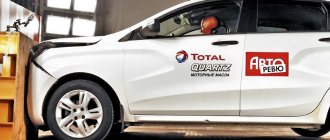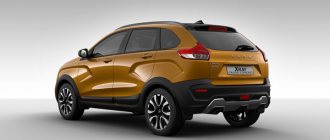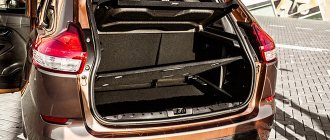08 August 2019 Lada.Online 10 685 4
In the summer, AVTOVAZ presented a new modification of the Lada XRAY Cross. Now this crossover is equipped with the Renault-Nissan H4m alliance engine (1.6 l, 114 hp) and the JF015E continuously variable automatic transmission (hereinafter referred to as “variator” or CVT). We found out how the car turned out during the test drive.
What does the car look like
The car is pre-production, but is already being manufactured on the VAZ assembly line. Well assembled. Gaps in the hood and fender, headlights, how the chrome trim is attached. The quality of painting is also at a high level. Design is a subjective thing, but after I saw the face of this car, I want something original in the back.
At the rear there is such a rounded stern, with rather scanty lights. Surely you could put them on the trunk, but that would cost more money.
Plastic fender liners front and rear have tides. They are designed to reduce snow accumulation. The trunk can be opened using a button on the key or on the trunk door. The trunk is small, but has its own characteristics. Here is a floor that can be installed on two levels. Either put it down, then there will be more volume, or put it 8 cm higher, forming a large underground.
The shelf is made roughly and the geometry does not correspond to the plane, so it rattles a little on bumps.
general information
On Lada Xray models, engines are available in three variations, but their general design is similar: gasoline inline four-cylinder units, with 4 valves per cylinder (16 valves in total) and two camshafts. True, this is where the similarities between the engines end. Considering the general characteristics of the Lada Xray, the engines installed on the model provide good power and torque, which is quite enough for everyday city use.
Let's take a closer look at which engines are equipped with x-rays and what are their main differences. However, before this it is worth mentioning that not all car models and trim levels are equipped with domestic power units. It will not be a secret for advanced car enthusiasts that new Lada models are created on the basis of the B0 platform. And since AvtoVAZ assembles models using Renault-Nissan technologies, many engineering solutions are borrowed from these manufacturers. The motor in this case was no exception, so AvtoVAZ installs the Nissan engine on the Xray in some trim levels.
Engine
They plan to install one of three engines on the Lada XRAY car. It is based on a VAZ 1.6 liter 106 liter. With. Then comes the Nissan 114 hp engine. With. the same displacement. The 122-horsepower 1.8-liter VAZ engine completes this line. In our case, 114 hp. Nissan engine, like the Nissan Beetle, Nissan Center. Open the hood and place the stop by hand.
The petrol tank hatch is large. There is a sticker on it: 91, 95, 98. This means that these gasolines can be used. In our conditions this is pleasant. The tank lid is simple without a lock, there is a loop on which you can hang the lid. There is no hatch lock. The door handle is well made and comfortable for the hand.
There is no rubber seal at the bottom of the door, so the thresholds get dirty. Behind the wheel the seat looks good. There are three adjustments, the seat heating button is in an awkward place, and there is no indicator on the instruments.
The steering wheel is pleasant, familiar from the Lada Vesta. The multifunction steering wheel has cruise control buttons on the left, and radio controls on the other side. The friction properties are not bad, although it is not covered with leather. There is no reach adjustment, only height adjustment. There's not much room in the back. The legs rest against the reinforcement of the front seat. The reinforcement is quite rigid. If the driver is tall, it will not be very comfortable to sit in the back, and the exit is inconvenient. The glove compartment has sufficient volume.
Reviews about the model
AvtoVAZ itself rates its own car quite highly. In particular, there is a competent setup of the chassis, which allows active maneuvering. An important role here is played by the front subframe and gas-filled shock absorbers, which provide traction on the surface. The energy intensity of the suspension, combined with high ground clearance and decent geometric cross-country ability, make it possible not to worry on the countryside and in the city. And the driver's position, cozy interior and excellent sound insulation complete the picture.
And the owners note in their reviews that a car equipped with an H4M engine causes practically no trouble. There are no problems with dynamics, it is also not noticeable in terms of noise, and the appetite is small - it usually does not rise above 9 liters even in a metropolis.
X-Ray has no problems with cross-country ability.
Dashboard
The front panel looks poor. The climate control unit is similar to Vesta. There is a joint: this panel breathes. We start the engine, but for some reason the instruments don’t come to life; we need backlighting. To see something on the instruments, you need to turn on the side lights. If nothing works, you can hardly see anything.
We compare with Vesta and Renault Logan or Sandero. My first thoughts were: yes, this is a VAZ, this is a Vesta, a new design. But from the first kilometers it becomes clear - this is Renault. A comfortable, quiet car that doesn’t make you want to drive fast, and doesn’t have that reckless handling of the Vesta. On the Vesta you want to drive fast, actively move, overtake, and take turns. Here you want to roll, drive at low speed. The stabilization system operates softly and smoothly, but cuts off traction.
This does not happen on Vesta; there we remain with a good supply of traction, even when the car begins to slide with the stabilization system working. Here everything should be calm, measured, smooth, that is, the ideology is more inherent in Renault cars, for which many people love these comfortable French cars.
They will probably love the Lada XRay too. Two weeks ago we tested all-wheel drive crossovers. The ditch was quite a difficult obstacle for them. Our Lada XRay car overcomes this ditch calmly.
Is it a lot or a little?
Indeed, some will say that for 90,000 km you can fork out an extra 37,100 rubles. However, many will object. Still, LADA XRAY belongs to the budget segment, where not only the cost of the car itself is important, but also the cost of its maintenance. Other things - dynamics, sound insulation, etc. - are not looked at so closely.
In light of such expenses, there are fewer and fewer people disappointed that AvtoVAZ is discontinuing the X-Ray with a Nissan engine. In addition, the start of sales of a crossover with a 122-horsepower Russian engine will more than compensate for the loss.
Lada X Ray engine, technical characteristics of Lada XRay engines, design features
The Lada X Rey engine , or rather the engines for the compact Russian crossover, will delight you with its power. After all, if you take into account the size and light weight of the car, then for example 122 hp. may be quite enough. The Lada XRay will have three power units in total. All of them are gasoline, naturally aspirated, in-line 4-cylinder with a 16-valve DOHC mechanism. Perhaps this is where the coincidences stop; otherwise, these are different power units. All Lada X Ray engines are of interest, so we will tell you about each in detail.
The base X-Ray VAZ-21129 engine has a displacement of 1.6 liters and a power of 106 hp. well known from other Lada models. The engine is fuel injected and has electronically controlled distributed fuel injection. When the belt breaks, the valve definitely bends. Yes, the timing belt needs to be looked after. But the cast iron block tells us about the good maintainability of the motor. This power unit does not have hydraulic compensators; adjustment is carried out by selecting special “nickels”, as on a regular VAZ-2108 engine.
the Lada XRay 1.6 (106 hp) power unit can be considered the original intake system. At low engine speeds, air is supplied through longer intake channels, and with increasing speed, on the contrary, through short ones. That is, the composition of the fuel mixture changes from lean to enriched and vice versa. This made it possible to increase power in almost all ranges of engine operation. Without this system, it was possible to squeeze only 98 hp out of the engine.
By the way, the engine will only be combined with a 5-speed manual JR5 from Renault, but assembled at Avtovaz. Below are detailed characteristics of this X-Ray power unit.
Engine Lada X Ray 1.6 (106 hp), fuel consumption, dynamics
- Working volume – 1597 cm3
- Number of cylinders/valves – 4/16
- Timing drive - belt
- Cylinder diameter – 82 mm
- Piston stroke – 75.6 mm
- Power hp/kW – 106/78 at 5800 rpm
- Torque – 148 Nm at 4200 rpm
- Maximum speed – 172 kilometers per hour
- Acceleration to the first hundred – 11.7 seconds
- Fuel consumption in the city – 9.3 liters
- Fuel consumption in the combined cycle – 7.0 liters
- Fuel consumption on the highway - 5.9 liters
The second XRay engine of the same volume is 1.6 liters, but with a power of 110 hp. This is a development of the Renault-Nissan concern. The engine in Nissan cars is called HR16, in Renault it is called H4M. The unit appeared in 2006 and since then has been installed on all mass-produced Renault-Nissan models around the world. The production of this engine was mastered at AvtoVAZ. Structurally, the unit is seriously different from VAZ engines with a cast iron block and timing belt.
The Lada X Rey engine is based on 110 hp. aluminum cylinder block and aluminum cylinder head. A timing chain is used as a timing drive . The 4-cylinder in-line 16-valve HR16DE or H4M does not have hydraulic compensators, but has a variable valve timing system on one shaft. Among the features of the unit, one can note the presence of two nozzles per cylinder. HR16 looks like this assembled with a CVT gearbox
But on X-Ray it will only be installed with a Renault 5-speed gearbox. The engine dynamics are quite good; below we offer more detailed characteristics.
Engine Lada XRay 1.6 (110 hp), fuel consumption, dynamics
- Working volume – 1598 cm3
- Number of cylinders/valves – 4/16
- Timing drive - chain
- Cylinder diameter – 78 mm
- Piston stroke – 83.6 mm
- Power hp/kW – 110/81 at 6000 rpm
- Torque – 156 Nm at 4000 rpm
- Maximum speed – 171 kilometers per hour
- Acceleration to the first hundred – 10.3 seconds
- Fuel consumption - n/a
Well, the third and most powerful engine for the X-Ray is a VAZ unit with a displacement of 1.8 liters and a power of 122 hp. This engine will be combined not only with a robotic automatic, but also with conventional mechanics. The actual production of the engine has been carried out for quite a long time by the Avtovaz subsidiary Super-Avto. The method of creating this engine initially involved boring the cylinder block to accommodate large pistons. That is, they took a regular 16-valve 1.6-liter engine and bored the block. The regular 1.6 liter engine has a cylinder diameter of 82 mm, while the modified one has 82.5 mm. But recently this modernization was abandoned, since the engine’s service life was short and oil consumption was very serious.
What is this
Auto Electrics Diagnostics ICE Chip Tuning in Nefteyugansk Tel.
7-9222-58-19-42TOYOTA COROLLA 120 with 3ZZ-FE 1.6L 16V engine does not pull TOYOTA COROLLA 120, with automatic transmission and 3ZZ-FE VVT-i 1.6L 16V engine 2004 stalls, does not pull, chokes. Final conclusion Symptom An engine is usually understood as a unit that converts a certain type of energy into mechanical work. All cars are equipped with this spare part. If the motor fails, the machine will stop working. The engine not only ensures the movement of the vehicle, but also serves to operate the vehicle’s auxiliary systems (for example, air conditioning).
The power unit, regardless of type, is represented by the following components:
- Cylinder block.
- Piston rings.
- Piston.
- Crank mechanism.
If the motor fails, it is impossible not to notice it. Service station specialists point out the following signs of engine malfunction:
- Increased oil consumption.
- Reducing engine power.
- The engine will not start.
- Reduced compression in the cylinders of the power unit.
- Plumes of thick smoke appearing from the muffler.
- The smell of burnt rubber, motor oil, and fuel appears in the car dealership.
- The occurrence of extraneous sounds during engine operation.
The causes of power unit failure may be:
- Air filter dirty.
- Use of low quality fuel.
- Engine overheating.
- Engine operation with insufficient lubrication.
- The occurrence of water hammer in the cylinder.
Which engine is best to buy a Lada X-Ray?
The new Russian-made car Lada X-Ray is available with three different engine model options. Among which you can choose both a powerful engine designed to increase the speed characteristics and cross-country ability of the car, as well as more economical options with lower power indicators for people who prefer to have an engine with low fuel consumption under the hood.
The new internal combustion engines have 106, 110 and 122 hp in their arsenal. And they are installed depending on the Lada Xray configuration. AvtoVAZ engines installed on the Lada X-Ray are made in compliance with European quality standards and are as safe as possible for the environment. Each unit has individual features and specific technical characteristics, which will be discussed further in the text.
Is there a difference in maintenance costs?
This question is much more important than it initially seems. Indeed, given approximately the same power, torque and minor differences in dynamic characteristics, many expect that the service price tags will be approximately the same. But it was not there! There is a difference and it is very significant!
In order to understand this, it is enough to simply calculate the total costs of undergoing scheduled maintenance of a LADA XRAY with a 110-horsepower H4M engine. As an example, it is reasonable to take a mileage of 90,000 km and prices at Moscow LADA dealership centers. In addition, it is immediately necessary to clarify that the service interval for the Nissan H4M engine and the domestic 106-horsepower unit is the same - 15,000 km. They can also be filled with the same oil from Rosneft.
There are no differences in the list of operations and components during the first 5 maintenance procedures – up to a mileage of 75,000 km. It is necessary to change the engine oil and filters (air, cabin and oil). The only difference is the price, since the components for a foreign motor are slightly more expensive than for a domestic one. In particular, the amounts for TO-1, TO-3 and TO-5 differ - for an X-Ray with a Russian engine, service will cost 5,900 rubles per visit, and for a hatchback with an H4M under the hood - 6,500 rubles.
The difference in the price for maintenance for X-rays with different engines is quite noticeable.
Everything is complicated by the situation with the spark plugs. Their replacement interval is indicated at 30,000 km, but not everything is so simple. For a VAZ engine, their cost is already included in the price of TO-2 and TO-4, which cost 6,400 rubles each. But owners of X-Rays with H4M units have to pay separately for both spark plugs and replacements. As a result, TO-2 and TO-4 cost 8,800 rubles each, and another 4,000 rubles for each of these TO will be spent on replacing spark plugs.
This cost is due to 2 factors:
- For the H4M, spark plugs from the NGK company are used, while for the Russian engine, spark plugs from Bosch, made in Russia (Saratov), are intended;
- Difficult to replace - to do this you have to dismantle the intake manifold and throttle.
The H4M engine requires expensive spark plugs, and changing them is not easy.
However, the greatest expenses await the owner of an imported engine after traveling the first 90,000 km, when the time comes for TO-6. For the owner of an X Ray with a Russian engine, this maintenance will cost 12,000 rubles, but the owner of a hatchback with an H4M engine will have to pay the dealer as much as 34,500 rubles (including spark plugs)!
The almost 3-fold difference in price is explained by the cost of the alternator belt and rollers. For a Nissan engine they are much more expensive than for a Russian one.
The result is not the most rosy, because for the first 90,000 km the owner of a Lada X-Ray with a domestic, 106-horsepower engine will need to pay a total of 42,500 rubles. But the costs of the owner of a LADA XRAY with an H4M engine will reach 79,600 rubles. The final difference is 37,100 rubles.
Possible internal combustion engine options for Lada X-Ray
Lada X-Ray has three engines that are offered to customers to choose from:
- VAZ-21129 - this option is used in the basic version of the Lada X-Ray and has a power of 106 horses;
- HR16DE – engine from foreign partners, is reliable and has 110 hp;
- VAZ 21179 is the most powerful engine of those installed on the Lada Xray, it has 122 hp.
All engines that are installed on the Lada X-Ray run on gasoline, and the most powerful version has a special VAZ automated manual transmission.
Size marking
For clarity, let’s read the inscription on the standard Lada XRay tire, for example: 195/65 R15. It means that the tire has the following dimensions:
- 195 – tire width in millimeters;
- 65 – tire profile height as a percentage of its width;
- 15 – disk size in inches.
The most incomprehensible quantity here is usually the profile height. In fact, it is not difficult to calculate it by converting it into understandable units: divide 195 by 100 and multiply by 65. The result is 126.75 millimeters.
It should be noted that low-profile “rubber” is considered if its height is less than 50% of the width. When independently choosing the size you require, keep in mind that a deviation of a value of up to 3 mm will not cause noticeable adverse consequences, and its value of 6 mm and above is simply unacceptable.
Engine VAZ-21129
This engine, intended for installation on the Lada Xray, differs from analogues in its special intake system. During its operation at low speeds, air is supplied differently - through elongated intake channels. If the speed increases, air begins to flow through short channels. As a result, the composition and consistency of the fuel mixture changes; in the first case, it is weakly saturated with oxygen, and in the second, vice versa. This operating principle allows you to significantly increase the power of the unit with relatively low fuel consumption. In the absence of such a system, a similar device produces no more than 98 horses.
Design nuances
The 21179 engine bears little resemblance to the basic version 21127, as both the design and appearance have changed:
- phasing of intake valves within ±30 degrees;
- hollow camshafts with cams using powder metallurgy;
- vortex air supply into the combustion chamber;
- cylinder cooling system (jacket);
- improved configuration and cylinder head gasket volumes;
- ShPG Federal Mogul;
- Korean pump;
- inclined drilling of oil channels in the crankshaft journals;
- polymer cylinder head cover and solid aluminum pan;
- flywheel for clutch 215 mm, which is recommended by the manufacturer.
Motor gaskets
ShPG from Federal Mogul
HR16DE and its features
This engine, which you can get with the new Lada X-Ray, has the same volume - 1.6 liters. But with a similar volume it has more power, which is 110 horsepower. HR16DE was developed for a Russian car by the friendly concern Renault-Nissan. It has proven itself on some models of these manufacturers and is widely known throughout the world. Therefore, we can say with confidence that the Lada Xray has a world-class unit. The new engine has a number of fundamental differences in relation to VAZ devices, which are equipped with cast iron blocks and conventional belts. The unit has an excellent reputation and promising technical characteristics. However, time will tell us which option is better.
HR16 is equipped with an aluminum cylinder block. The cylinder head is made of aluminum alloy. Instead of a timing belt, this device has a stronger and more durable metal chain. The engine is made without hydraulic compensators, but at the same time, it is equipped with a system for changing the gas distribution phases. Each cylinder has two injectors.
The HR16 engine is installed in the Lada X-Ray car in combination with a French gearbox from Renault. Based on reviews from car enthusiasts, we can conclude that the HR16 has excellent dynamics and works flawlessly. Engine characteristics:
- volume – 1598 cm3;
- has 4 cylinders, 16 valves;
- instead of a timing belt, a chain is used;
- the cylinder has a diameter of 78 millimeters;
- power – 110 hp
To reach a speed of one hundred km/h from zero, the Lada Xray will take 10.3 seconds. And the maximum speed is 171 km/h.
Available body types
Largus owner reviews all cons
Reviews about the characteristics of the Lada Vesta create a pleasant impression. Many car enthusiasts have the feeling that we are not talking about the products of the more than once disgraced AvtoVAZ, but about a solid, brand new budget-class foreign car.
It is worth noting that at this stage the Lada Vesta sedan, the characteristics of which have already amazed the public, is the only mass-produced body type. AvtoVAZ facilities will be ready to produce a hatchback of this model by the end of spring 2016, and the model after restyling will undergo all kinds of test drives and will be released for sale only by the fall.
The best news is saved for last. The technical characteristics of the Lada Vesta station wagon promise to become something qualitatively different and superior to the capabilities of a sedan and hatchback. Information about the exact performance of this model is not yet available, but work on creating a Vesta of this type is already underway at the concern. It is worth noting that the plant management promises to make this station wagon a real crossover: the characteristics of the Lada Vesta will fully correspond to this title. According to experts, we should expect higher fuel consumption and more power from the standard engine that powers all-wheel drive, as well as independent soft suspension. In this case, the station wagon risks becoming a real pearl of AvtoVAZ, and such success can overshadow past failures. Unfortunately, it is currently not possible to find out anything about the characteristics of the Lada Vesta Cross, but the release of the crossover is planned immediately after the release of the hatchback.
VAZ-21179
The most powerful engine for the Lada Xray is manufactured directly by AvtoVAZ. It has excellent technical characteristics and is combined with a robotic gearbox. For the Lada X-Ray, the development of this unit was carried out by a branch of AvtoVAZ called “SuperAuto”.
Larger volume in this engine is achieved by increasing the stroke of the piston itself, and not by boring the cylinder block, as was done previously. The size of the connecting rods and crankshaft has been changed. The engine assembly uses foreign graphite pistons from the famous Federal-Mogul brand.
This new engine used in the Lada Xray has fewer small parts, which increases its reliability and performance without affecting performance. The unit has impressive torque. Lada Xray, equipped with such an engine, consumes significantly less oil. The VAZ 21179 engine for Lada Xray has the following technical characteristics:
- volume - 1797 cubic centimeters;
- 4 cylinders/16 valves;
- timing belt drive;
- Cylinder D – 84 mm;
- Power – 122 hp.
With these internal combustion engine parameters, the Lada Xray will develop max. Speed 182 km/h. The car will accelerate to 100 km/h in just over 10 seconds. Fuel consumption depending on the driving cycle:
| Cycle | Consumption (l) |
| City | 8,8 |
| Mixed mode | 7,5 |
| Route | 6 |
A Lada Xray equipped with such an engine will have excellent speed characteristics, but will also save on fuel.
Maintenance
The actual life of the internal combustion engine is still unknown due to the short service life of the first cars that rolled off the assembly line in 2016. However, to increase it, engine 21179 should be serviced according to the regulations below:
- 10,000 km means changing the filter/oil;
- twice as long, the alternator belt runs 30,000 km;
- after 45,000 km, change hoses/fittings and antifreeze;
- spark plugs and batteries are enough for 60,000 km;
- About 180,000 the original timing belt passes.
For 2022, the internal combustion engine device is considered the most advanced in the AvtoVAZ manufacturer’s line. In practice, his project had been considered since 2006, but was constantly postponed until the technical, economic and market situation in the Russian Federation finally developed favorably. That is, AvtoVAZ in this project prioritized the power output of the engine, and not economical fuel consumption, as was usually the case before.
To make the motor last a long time
Minimal engine wear requires certain conditions to be met. It is important to know exactly how much oil is in the engine. This is the only way you can avoid the unpleasant process of moving parts in the motor rubbing against each other. This indicator directly depends on the presence of the required amount of oil in it. This indicator depends on the type of internal combustion engine used in the crossover. Motors 21179 and 21129 will require oil of a compatible brand and viscosity in a volume of 4.2 liters. For the HR16DE (H4M) internal combustion engine, this figure will be slightly more – 4.3 liters.
It is unacceptable for the oil level to drop below o or exceed the “max” indicator. They are applied to a special dipstick to measure the amount of oil in the engine. Always check the level only when the car is parked on a level surface and with the engine turned off. The procedure is performed at least 2 times every 14 days. If there is the slightest doubt about the correctness of the measurements, they should be repeated as soon as possible.











